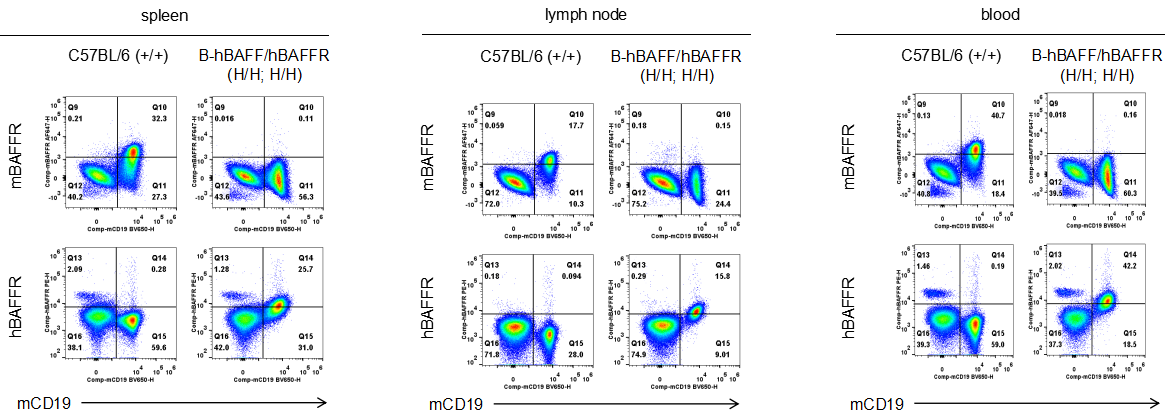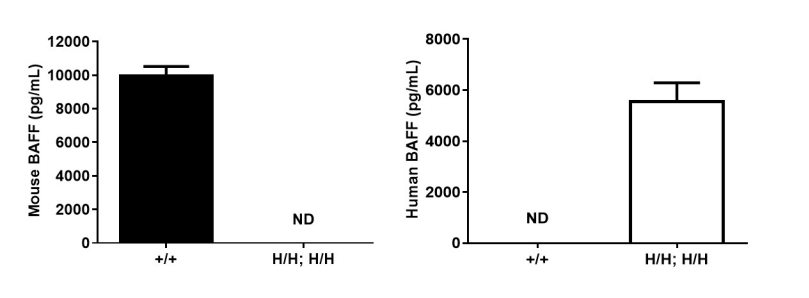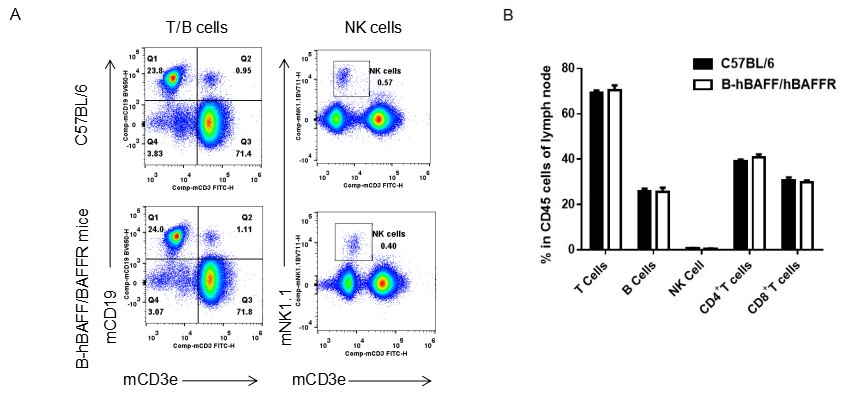B-hBAFF/hBAFFR mice
| Strain Name |
C57BL/6-Tnfsf13btm1(TNFSF13B)Bcgen Tnfrsf13ctm1(TNFRSF13C)Bcgen/Bcgen |
Common Name | B-hBAFF/hBAFFR mice |
| Background | C57BL/6 | Catalog number | 111921 |
|
Aliases |
TNFSF13B, BAFF, BLYS, CD257, DTL, TALL-1, TALL1, THANK, TNFSF20, TNLG7A, ZTNF4, TNF superfamily member 13b; TNFRSF13C, BAFF-R, BAFFR, BROMIX, CD268, CVID4, prolixin, TNF receptor superfamily member 13C |
||

Strain specific BAFFR expression analysis in homozygous B-hBAFF/hBAFFR mice by flow cytometry. B cells from spleen, lymph node and blood were collected from wild type (WT) mice (+/+) and homozygous B-hBAFF/hBAFFR mice (H/H; H/H), and analyzed by flow cytometry with species-specific anti-BAFFR antibody. Mouse BAFFR was detectable in WT mice (+/+). Human BAFFR was exclusively detectable in homozygous B-hBAFF/hBAFFR mice (H/H; H/H) but not in WT mice (+/+).

Strain specific BAFF expression analysis in wild type (WT) mice and B-hBAFF/hBAFFR mice by ELISA. Serum were collected from WT mice (+/+) and homozygous B-hBAFF/hBAFFR mice (H/H; H/H), and analyzed by ELISA with species-specific BAFF ELISA kit. Mouse BAFF was detectable in WT mice (+/+). Human BAFF was exclusively detectable in homozygous B-hBAFF/hBAFFR mice (H/H; H/H) but not WT mice (+/+). Values are expressed as mean ± SEM. ND: not detectable.

Analysis of spleen leukocyte subpopulations by FACS.Splenocytes were isolated from female C57BL/6 and B-hBAFF/hBAFFR mice (n=3, 7 week-old). Flow cytometry analysis of the splenocytes was performed to assess leukocyte subpopulations. A. Representative FACS plots. Single live cells were gated for CD45 population and used for further analysis as indicated here. B. Results of FACS analysis. Percent of T cells, B cells, NK cells, dendritic cells, granulocytes, monocytes and macrophages in homozygous B-hBAFF/hBAFFR mice were similar to those in the C57BL/6 mice, demonstrating that introduction of hBAFF and hBAFFR in place of its mouse counterpart do not change the overall development, differentiation or distribution of these cell types in spleen. Values are expressed as mean ± SEM.
Analysis of lymph node leukocytes cell subpopulations in B-hBAFF/hBAFFR mice

Analysis of lymph node leukocyte subpopulations by FACS.Leukocytes were isolated from female C57BL/6 and B-hBAFF/hBAFFR mice (n=3, 7 week-old). Flow cytometry analysis of the leukocytes was performed to assess leukocyte subpopulations. A. Representative FACS plots. Single live cells were gated for CD45 population and used for further analysis as indicated here. B. Results of FACS analysis. Percent of T cells, B cells and NK cells in homozygous B-hBAFF/hBAFFR mice were similar to those in the C57BL/6 mice, demonstrating that introduction of hBAFF and hBAFFR in place of its mouse counterpart do not change the overall development, differentiation or distribution of these cell types in lymph node. Values are expressed as mean ± SEM.

Analysis of blood leukocyte subpopulations by FACS.Blood cells were isolated from female C57BL/6 and B-hBAFF/hBAFFR mice (n=3, 7 week-old). Flow cytometry analysis of the blood leukocytes was performed to assess leukocyte subpopulations. A. Representative FACS plots. Single live cells were gated for CD45 population and used for further analysis as indicated here. B. Results of FACS analysis. Percent of T cells, B cells, NK cells, dendritic cells, granulocytes, monocytes and macrophages in homozygous B-hBAFF/hBAFFR mice were similar to those in the C57BL/6 mice, demonstrating that introduction of hBAFF and hBAFFR in place of its mouse counterpart do not change the overall development, differentiation or distribution of these cell types in blood. Values are expressed as mean ± SEM.











 京公網安備: 11011502005564號
京公網安備: 11011502005564號